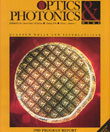
February 1990 Issue
Feature Articles
Color perception is a prime candidate for an optics lesson because children are keenly aware of colors and often already curious about them. If white is a combination of all colors, why do you get a muddy brown when you mix all the paints in your paintbox? Why do people talk about "all the colors in the rainbow" when pink and mint green aren't found in rainbows at all?
by Robert E. ParksOptoelectronic applications of quantum wells
The successful applications of optics in communications and in consumer electronic products give us great confidence in, and renewed expectations for, optics and optoelectronics. We hope to continue making new and better systems by combining the complementary abilities of these two fields. Optics excels in some areas where electronics is weaker, such as in communication of information. The challenge—and the opportunity—is to get the best out of both. However, this creates a demand for new optoelectronic devices.
by D.A.B. MillerIEC/ISO publish standards writing primer
As promised, this month's focus is on the three-volume IEC/ISO Directives for the preparation of international technical standards—Procedures for the technical work, Methodology for the development of International Standards, and Drafting and presentation of International Standards. The procedures volume details the establishment of technical committees and subsidiary groups, and secretariats to support their work. It then reviews the five stages in the development of International Standards, from proposal through publication, including schedules. Sample document forms for each step are given in the 13 appendices.
by Robert E. Parks

![Manual probe system with needles for test of semiconductor on silicon wafer. [A. Morozov / Getty]](https://opnmedia.blob.core.windows.net/$web/opn/media/images/articles/2025/1125/departments/202511-cover-web.jpg?ext=.jpg)
![Researcher Clara Saraceno in the lab. [Image by Carsten Behler Photography]](https://opnmedia.blob.core.windows.net/$web/opn/media/images/articles/2025/1025/departments/202510-cover-web.jpg?ext=.jpg)
